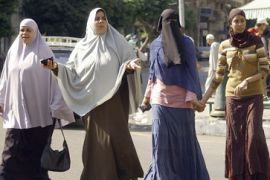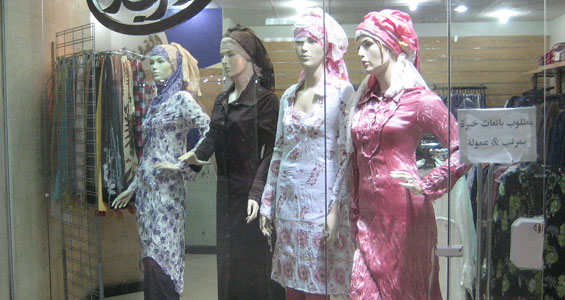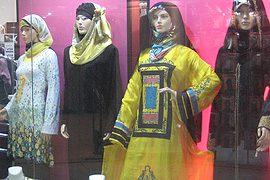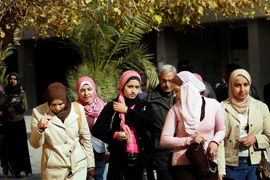The multiple shades of the hijab
Scholars fear recent trends signal that the hijab may become a fashion statement.

 |
| A boutique catering to stylish hijab fashions in Cairo [MEGEED] |
When a US-based television network introduced Ro’ya Zanaty, a veiled Egyptian woman, as part of its “21 and the World is Yours” programme, it portrayed her as a “combination of contradictions”.
A Western audience may find it an interesting – if not novel – story that a veiled Muslim woman listens to pop music and is willing to approach a man and ask him out.
Keep reading
list of 4 itemsTen years after Chibok girls kidnapping: One woman’s struggle to move on
Poland lawmakers take steps towards liberalising abortion laws
Polish lawmakers debate reforming strict abortion laws
But for many in Egypt and the Middle East, a veiled woman mixing eastern and western traditions is nothing new.
In the past two decades, young veiled women have been increasingly active in society – they can be seen in universities, cafes, sports clubs, and mixed social gatherings, hosting talk shows and commenting on everything from contemporary politics to sex education and the latest fashion sense.
And though they appear to share a common adherence to the hijab, they have been expressing themselves in different ways even to the point where the veil itself has now become a symbol of distinct religious and social meanings.
Mona Abaza, a sociology professor at the American University in Cairo, believes the hijab has transformed itself from a symbol of piety into a cultural mechanism, a political statement, and finally, a fashion trend.
“Like any other religious symbol, hijab has taken multiple meanings through time,” she said.
1970s piety
Despite the emergence of religious activism in Egypt in the 1920s, hijab remained far from a phenomenon in Egyptian society until the 1970s and 1980s.
In the aftermath of the Arab defeat in 1967 and stalemate against Israel in 1973, Arab populations became increasingly disillusioned with secular pan-Arabist ideals.
This paved the way for Islamist ideologies to gain ground in schools, mosques and eventually the family living room.
The slow transformation of Egypt’s secular society into an increasingly Islamic one was also propelled by events unfolding in the country’s parliament.
Anwar Sadat, then the Egyptian president, curried favour with more conservative and religious forces in his bid to curb Nasserist influence in government.
Sadat’s tactics inadvertently created the social catalyst which fuelled the hijab phenomenon.
“The Islamist movement of the 1970s was born out of Sadat’s support, but by the end of the decade it was clear that it went out of his control,” Abaza told Al Jazeera.
And in spite of the turmoil of the 1990s – which were dominated by the battle between the government and militant Islamist groups, Egypt continued to witness a steady growth of religiosity in general due to the efforts of the more moderate Islamist grass-roots organizations.
As a result, more women began to wear the veil.
Thriving business
 |
| Veiled women are experimenting with different hijab styles [MEGEED] |
In recent years, several clothiers catering to veiled women’s demands for ready-made garments have started to dot the commercial landscape.
As more teenagers and fashion-conscious women from upper middle class backgrounds don the hijab, store managers are experimenting with fashionable scarf styles, tying techniques, and designs in a bid to win over consumers.
“At one point, there were hardly any clothes for veiled women. Taking the veil meant wearing a galabyya [long, loose robe] like older generations of women. However, nowadays veiled women can dress fashionably,” said Riham Farouq, a fashion designer and the owner of Veil – a chain of stores for veiled women’s ready-made garments.
Farouq, who tries to make her designs part of the spirit of the age, views no contradiction between hijab and fashion.
Many women have picked up on the hijab-chic trend and started grooming businesses where veiled women can have their scarves arranged for different occasions – from graduation parties to weddings.
Essam Aziz, the owner of Hijab Fashion, a monthly magazine, believes that most veiled women today know how to look presentable.
He says his magazine does not convey a religious message and merely gives veiled women shopping options and reviews.
“We launched our magazine in 2004. We simply aim to fulfil an existing need,” he said.
“We do not create the styles that determine the latest trend of hijab fashion; rather, we simply respond to what people want,” he told Al Jazeera.
Dwindling religiosity?
However, in the age of reality shows about cat walks, aspiring models and the newest pop music contestant, some sociologists believe that the religiosity of the hijab is being overshadowed by its fashion appeal.
Spiralling motifs and coloured and bleached designs have elbowed their way into the market, rendering classical plain-coloured hijab styles old-fashioned.
The “Spanish wrap” – a tying technique in which the headscarf is wrapped behind the neck – has become a favourite style for young veiled women.
Also, thanks to long-sleeved, close-fitting tops, veiled women can buy any piece of clothing, from strapless tops to backless dresses.
In a society where expression of sexuality remains a taboo, Abaza believes that by adapting sexy outfits to the hijab, young women are attempting to be veiled and appealing at the same time.
“Today, everybody wants to be attractive, which has given rise to a chic, consumerist version of hijab,” she added.
But critics say new hijab techniques reveal the neck and sometimes a part of the chest, and therefore fail to embrace the essence of what it means to be veiled. While some consider this a deviation from the real purpose of hijab, others think that it is a tolerable expression of individuality.
But Aziz says some recent trends in hijab clothing are ostentatious and he finds them not only beyond acceptable limits, but also tasteless.
“Huge earrings popping out of the headscarf, odd combinations of colours, skin-tight clothes wrapped about the body are common among many veiled women today,” he said.
He believes recent hijab trends are due to a lack of self-confidence and identity.
“Today, hijab itself does not mean a specific thing, but perhaps the hijab style does. Hijab is not an indication of religiosity anymore,” he added.
‘Petro-Islam’
 |
| Changing trends are seen in Iraq, the Gulf, and the rest of the Middle East [GETTY] |
Aziz points to the influence of the culture of the Gulf region, arguing that it gave momentum to the hijab phenomenon in the 1980s.
But he believes that as early as the 1990s, the phenomenon took a different turn that moved it away from its original track.
“The large number of Egyptian middle-class families who travelled to Gulf countries resulted in the emergence of ‘petro-Islam’. This segment of society returned home with a version of Islamism that did not contradict with consumerist values prevalent in the Gulf region, paving the way for new hijab styles,” Abaza told Al Jazeera.
Noha Maarouf, a Cairo-based social psychologist, believes that hijab has turned into a social phenomenon that does not necessarily reflect religiosity.
However, she thinks that it is important to draw a distinction between those who adopt hijab out of religious sentiments and those who are merely jumping on the bandwagon.
“Many people are rallying behind the superficial aspects of religion because of the absence of a common cause,” she explained.
Though there were fewer signs of popular piety in the 1950s and 1960s many Arabs and Egyptians generally look back on that era with a sense of nostalgia.
“In the past, less women wore hijab, but people were definitely more religious than today. Ethics are the core of religion, not appearance,” Maarouf said.
But for Radwa Abul-Azm, a 25-year-old veiled woman, the stylish hijab phenomenon, can also be viewed through a broader cultural prism.
“For a big part of society, particularly in rural and low-class areas, wearing hijab is merely a cultural practice. Some of the veiled women in those areas don’t even know how to pray,” she said.
Secularising religious symbols
Asef Bayat, professor of sociology and Middle Eastern studies, believes there is a general trend to secularise religious symbols.
“Egypt experienced some kind of culture hybridism in which religion remained by and large dominant,” he wrote in his research treatise, Revolution without Movement, Movement without Revolution: Comparing Islamic Activism in Iran and Egypt.
In Egypt, religion and culture have never been exclusive spheres; rather, they have always been interlinked in a way that sometimes blurs the distinction between what is cultural and what is religious.
“Religion and culture are closely entwined in most societies, particularly in Third World countries. Yet, culture colours religion, and not vice versa,” Maarouf told Al Jazeera, commenting on the influence of culture on religious practices, including hijab.
Abaza, however, does not believe that hijab is an inherent part of Egyptian culture, but is rather an “invented tradition”.
“Where was it during the 1960s? You could hardly find a single veiled woman at Cairo University during that time,” she said.